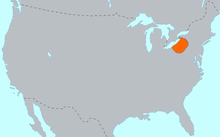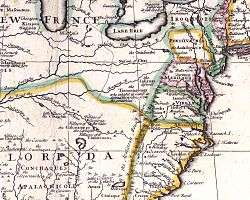Erie people

The Erie people (also Erieehronon, Eriechronon, Riquéronon, Erielhonan, Eriez, Nation du Chat) were a Native American people historically living on the south shore of Lake Erie. An Iroquoian group, they lived in what is now western New York, northwestern Pennsylvania, and northern Ohio before 1658.[1] They were destroyed in the mid-17th century by five years of prolonged warfare with the neighboring Iroquois, especially the Seneca, for helping the Huron in the Beaver Wars for control of the fur trade."[1]
Their villages were burned as a lesson to those who dare oppose the Iroquois, adding to their loss of life and likely forcing emigration. The Iroquoian confederacies were known for adopting others into their tribes, and true to form, the remaining defeated Erie are believed to have been absorbed by other Iroquoian tribes, particularly the Seneca, and possibly their kindred Susquehannocks with whom they shared the hunting grounds of the Allegheny Plateau and the Amerindian paths through the gaps of the Allegheny. Whatever their individual fates, the remnant tribes[2] living among the Iroquois, gradually lost their independent identity.
The names Erie and Eriez are shortened forms of Erielhonan, meaning "long tail." The Erielhonan were also called the Chat ("Cat" in French) or "Raccoon" people, referring to that characteristic. It appears that the cat reference may be to depict a connection to the sacred Underwater Panther, who was believed to have lived in the Great Lakes.[3] Like all the Iroquoian stock, they lived in multi-family long houses in villages enclosed in palisades, which often enclosed crops. They cultivated the "Three Sisters": varieties of corn, beans, and squash, during the warm season. In winter, tribal members lived off the stored crops and animals taken in hunts.
History

Clip from John Senex map ca 1710 showing the people Captain Vielle passed (1692–94) by to arrive in Chaouenon's country, as the French Jesuit called the Shawnee
While indigenous peoples lived along the Great Lakes for thousands of years in succeeding cultures, historic tribes known at the time of European encounter began to coalesce by the 15th and 16th centuries. The Erie were among the several Iroquoian peoples sharing a similar culture, tribal organization and speaking an Iroquoian language; nations which may have originated in the south[lower-alpha 1] Traditional rivalries and habitual competition among Amerindian tribes for resources (especially fire arms) and power was escalated by the lucrative returns of the fur trade with French and Dutch colonists beginning settlements in the greater area before 1611. Violence for fur bearing territories, the beginnings of the long running Beaver Wars, began early in the 17th century[lower-alpha 2] so the normal peace and trading activity decreased between the tribes, who had responded to demand for beaver and other furs by over-hunting some areas.
The Erie encroached on territory other tribes considered theirs.[4] During 1651,[4] they'd angered their eastern neighbors, the Iroquois League, by accepting refugees from their allies,[1] the Huron villages which had been destroyed by the Iroquois. Though rumored to use poison-tipped arrows (Jesuit Relations 41:43, 1655–58 chap. XI), the Erie were disadvantaged in armed conflict with the Iroquois because they had few firearms.[4][lower-alpha 3] By the mid-1650s, the Erie became a broken tribe— beginning in 1653[1] the Erie launched a preemptive attack on western tribes of the Iroquois, and did well in the first year of a five year war.[1]
Consequently, in 1654 the whole Iroquois Confederacy went to war against the Erie and neighboring tribes such as the Neutral people along the northern shores of Lake Erie and across the Niagara River, the Tabacco people between the Erie and Iroquois, neighbors to all three groups. As a result, over five years of war they destroyed the Erie confederacy, the Neutrals, the Tobacco, with the tribes surviving in remnants. Dispersed groups survived a few more decades before being absorbed into the Iroquois, especially the westernmost Seneca nation.
Anthropologist Marvin T. Smith (1986:131–32) theorized that some Erie fled to Virginia and then South Carolina, where they became known as the Westo. Some were said to flee to Canada. Members of other tribes claimed later to be descended from refugees of this defunct culture, who intermarried with other peoples. Among those are members of the Seneca people in Oklahoma and Kansas.
Because the Erie were located further from the coastal areas of early European exploration, they had little direct contact with Europeans. Only the Dutch fur traders from Fort Orange (now Albany, New York) and Jesuit missionaries in Canada reported on them in historic records. The Jesuits learned more about them during the Beaver Wars, but most of what they learned, aside from a single in-person encounter, was learned from the Hurons which pre-deceased the Erie.[4] What little is known about them has been derived from oral history of other Native American tribes, archaeology, and comparisons with other Iroquoian peoples.
Language
The Erie spoke an Iroquoian language said to have been similar to Wyandot.
See also
- Neutral Nation
- Wenrohronon - also known as the Tabacco people
- Shawnee
- Susquehannock people
Notes
- ↑ In Virginia, visiting Susquehannocks were described by an admiring Captain John Smith. Further, Tuscarora and Cherokee lived in the south from before Jamestown was founded, and the powerful Susquehanna had a lock on the Susquehanna basin into the upper Chesapeake Bay shores, probably into the northern Shenandoah Valley. The editors of New American Heritage state the various confederacies of Iroquoian tribes migrated from south to the Great Lakes regions and in between well before pre-Columbian times. Conversely, others such as the editors of the 1911 Encyclopædia Britannica suggest the tribes originated in what became Algonkian territories along the Saint Lawrence and moved west and south when the Algonquian tribes moved north up the coast then spread west. Whatever the truth of migrations, by the time the Europeans encountered Indians, Algonkian and Iroquoian tribes generally did not get along well, though were known to conduct trading and spent most years in uneasy peace. Separation between tribes living in wilderness ensured contacts were mainly small affairs before fire arms tipped the balance of warfare to enhance the killing ability of a people who could not out run a bullet, a limitation which existed before guns and the ability to kill at range.
- ↑ Beaver Wars are usually blamed upon the Iroquois who were believed to have a joint population dwarfed by surrounding tribes.
- ↑ If the Erie tribe had used poison on their arrows, they would have been the only tribe in North America to do so.[5]
Footnotes
- 1 2 3 4 5 Editor: Alvin M. Josephy, Jr., by The editors of American Heritage Magazine (1961). "The American Heritage Book of Indians". In page 197. ,. American Heritage Publishing Co., Inc. LCCN 61-14871.
[while the Iroquois were mopping up the Huron] ...the Erie... struck first in 1653. The next year [a counter-offensive] ...a victory which should have won the war on the spot, but ...two more years of fighting were required before the Erie, too, had been vanquished.
- ↑ According to The American Heritage Book of Indians the Susquehannock were poised to wipe out the Iroquois after administering severe drubbings into 1668, only to be laid low by multi-year disease epidemics 1669-1671; by 1672-1673 they were beset on all sides and like the Erie, went extinct as a drastically depopulated people with a small percentage of survivors dispersed among their kindred tribes. The Iroquois adopted their remnants under the terms of a formal treaty in 1678. Some of the Susquehannocks fleeing during 1776 triggered Bacon's Rebellion in the south.
- ↑ http://www.academia.edu/823402/Horned_Panthers_and_Erie_Associates
- 1 2 3 4 ERIE HISTORY, "The Erie needed beaver for this trade and probably encroached on other tribal territories to get it. The result was a war with an unknown Algonquin enemy in 1635 that forced the Erie to abandon some of their western villages.", 2016-0612.
- ↑ Tooker 1978 and Snyderman 1948, "doubts poisoned arrows". Anthony P. Schiavo, Claudio R. Salvucci, Iroquois Wars: Extracts from the Jesuit Relations and Primary Sources, p.11 ISBN 1-889758-37-X
References
- Bowne, Eric E. (2005). The Westo Indians: slave traders of the early colonial South. Tuscaloosa, Ala.: University of Alabama Press. ISBN 0-8173-1454-7. OCLC 56214192.
- Bowne, Eric E. (2006), "Westo Indians", The New Georgia Encyclopedia, Georgia Humanities Council and the University of Georgia Press
- Engelbrecht, William E. (1991), "Erie", The Bulletin: Journal of the New York State Archaeological Association (102): 2–12, OCLC 17823564
- Engelbrecht, William E.; Lynne P. Sullivan (1996). "Cultural context". In Lynne P. Sullivan (ed.). Reanalyzing the Ripley Site: earthworks and late prehistory on the Lake Erie Plain. New York State Museum Bulletin 489. Albany: University of the State of New York, the State Education Department. pp. 14–27 [volume References, 176–87]. ISBN 1-55557-202-2. OCLC 38565296.
- Hewitt, J. N. B. (1907), "Erie", in Frederick Webb Hodge (ed.), Handbook of American Indians north of Mexico, part 1, BAE Bulletin 30, Washington, D.C.: Government Printing Office, pp. 430–32
- Smith, Marvin T. (1987), Archaeology of aboriginal cultural change in the interior Southeast: depopulation during the early historic period, Ripley P. Bullen Monographs in Anthropology and History 6, Gainesville, Fla.: University Press of Florida, OCLC 15017891
- White, Marian E. (1961), Iroquois culture history in the Niagara Frontier area of New York State, University of Michigan Museum of Anthropology Anthropological Papers 16, Ann Arbor, Mich., OCLC 18903624
- White, Marian E. (1971), "Ethnic identification and Iroquois groups in western New York and Ontario", Ethnohistory, 18 (1): 19–38, doi:10.2307/481592
- White, Marian E. (1978), "Erie", in Bruce G. Trigger (ed.), Handbook of North American Indians, Vol. 15: Northeast, Washington, D.C.: Smithsonian Institution, pp. 412–17
- Wright, Roy A. (1974), "The People of the Panther-a long Erie tale (an ethnohistory of the southwestern Iroquoians)", in Michael K. Foster (ed.), Papers in linguistics from the 1972 Conference on Iroquoian Research, Mercury Series Paper 10, Ottawa: National Museum of Man. Ethnology Division, pp. 47–118, OCLC 1429124
External links
- "Erie", Encyclopedia of Oklahoma History and Culture
- "Erie History", unreferenced amateur history by Lee Sultzman